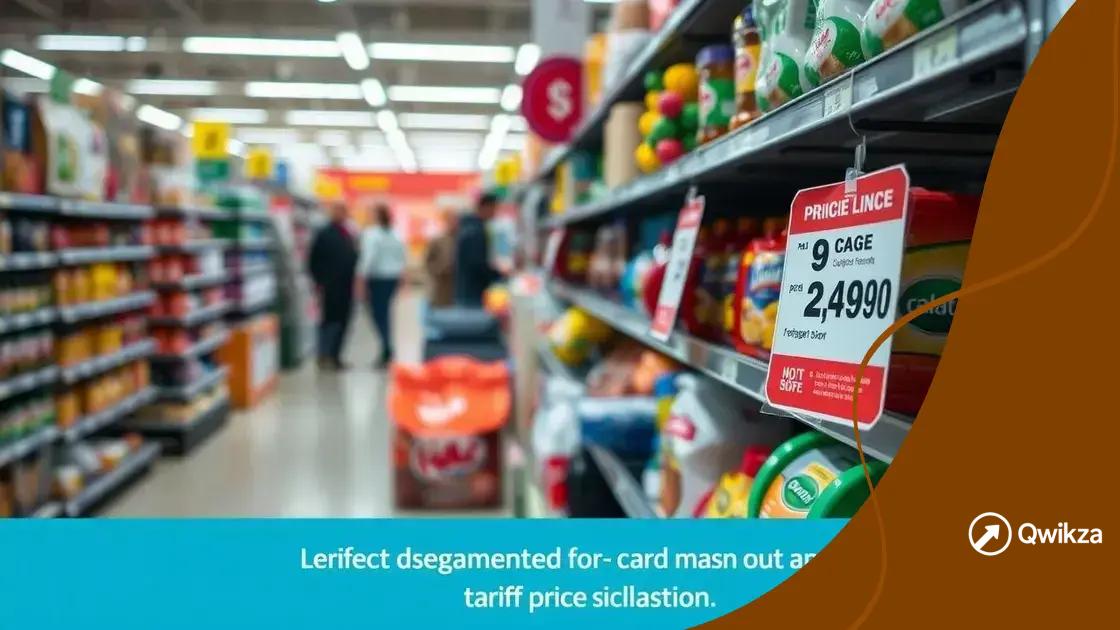Retailers feel effects of new tariffs on their business

Retailers feel effects of new tariffs through increased prices, shifts in consumer behavior, and the need for strategies like local sourcing and technology adoption to navigate the challenging economic landscape.
Retailers feel effects of new tariffs that can ripple through their operations and ultimately impact consumers. Curious about how these changes might affect your shopping experience? Let’s dive into the real consequences and findings surrounding this topic.
Understanding the new tariffs
Understanding the new tariffs is essential for anyone involved in retail. These tariffs are taxes imposed on imported goods, and they can have significant impacts on pricing and availability.
As tariffs change, it’s important to recognize how they affect various aspects of the retail environment. Here are a few key points to consider:
What are tariffs?
Tariffs are designed to protect domestic industries from foreign competition. When new tariffs are introduced, they raise the costs for retailers who rely on imported products. This often leads to a chain reaction in the market.
The impact on pricing
Retailers may be forced to increase prices to cover the higher costs brought on by these tariffs. Consumers can expect to see changes in these prices in the store.
- Higher costs for everyday items like electronics and clothing.
- Possible delays in product availability due to supply chain issues.
- A shift in buying patterns as consumers seek alternatives.
Additionally, the impact of these tariffs doesn’t stop at prices. They influence how retailers manage their supply chains and negotiate with suppliers. With increasing costs, retailers might look for new suppliers or even reconsider the products they offer to customers.
The retail landscape is constantly evolving. Understanding how new tariffs affect retailers and consumers is a critical step in navigating these changes. Being informed helps consumers make better purchasing decisions and allows retailers to strategize effectively to maintain their competitive edge.
How tariffs affect retail pricing
Understanding how tariffs affect retail pricing is crucial for both retailers and consumers. When new tariffs are implemented, prices can change dramatically, impacting what buyers pay for products.
Retailers face increased costs for imported goods, leading to higher prices on the shelves. This adjustment can cause consumers to reconsider their purchases, as they might seek alternatives or delay buying.
Direct impacts of tariffs on prices
When tariffs increase, retailers often respond by raising prices. This can lead to a noticeable difference in the cost of goods, particularly for imported items. Here are some of the key outcomes:
- Higher prices on electronics, clothing, and luxury goods.
- Increased transportation costs passed down to customers.
- Limited availability of products as retailers adjust inventory.
Moreover, these price increases can influence consumer behavior. Many shoppers may start looking for substitutes, such as domestic products that are less affected by tariffs. This shift can create opportunities for local businesses while challenging those who rely heavily on imports.
In the long run, understanding the relationship between tariffs and retail pricing helps consumers make informed choices about where to shop and what to buy. As prices fluctuate, keeping an eye on trends can save shoppers money and improve their overall shopping experience.
Consumer behavior changes due to tariffs

Consumer behavior changes due to tariffs can be significant and often unexpected. When tariffs are introduced, shoppers may react in various ways, reflecting concerns over rising prices and product availability.
Many consumers start to evaluate their spending patterns. They may shift their focus toward local products that are less affected by international tariffs. This shift can support local businesses and reduce reliance on imported items.
Adapting shopping habits
As prices increase for imported goods, consumers often change where they shop. Here are some common responses:
- Increased demand for domestic brands that are not impacted by tariffs.
- More cautious spending on non-essential goods.
- Heightened interest in sale items and promotions to mitigate cost increases.
People may also feel frustrated when prices rise, impacting their overall shopping experience. This frustration can lead to negative perceptions of brands that pass these costs onto consumers.
Moreover, it’s not just about price. Some consumers may choose to delay purchases until they can find better deals. Others might explore alternative retailers known for better pricing or bargain offerings.
Understanding these patterns helps businesses tailor their marketing strategies and product offerings to meet changing consumer needs. Being aware of how tariffs influence behavior is valuable for both retailers and shoppers.
Strategies retailers use to adapt
Strategies retailers use to adapt to changes brought by tariffs are essential for survival in the market. When tariffs increase, retailers must be flexible and innovative to maintain profitability while meeting customer needs.
One common strategy is adjusting pricing. Retailers may choose to absorb some of the tariff costs instead of passing all increases to consumers. This approach can help retain customers who might otherwise seek cheaper options.
Creative sourcing
Another strategy involves sourcing products differently. Retailers might look for alternative suppliers or switch to domestic products. This change not only helps reduce costs but also appeals to consumers wanting to support local businesses.
- Exploring new suppliers in non-tariffed regions.
- Increasing local production to avoid import issues.
- Negotiating better deals with current suppliers.
Additionally, retailers often focus on enhancing their marketing strategies. By effectively communicating the reasons behind price changes, they can build trust with customers and explain their efforts to mitigate the impact of tariffs.
Another important response is inventory management. Retailers may adjust their stock levels to avoid overstocking items that have become more expensive due to tariffs. This proactive approach helps in minimizing financial losses and keeping customers satisfied.
Adapting to tariffs requires creativity and strategic thinking. Retailers must remain vigilant and responsive to the changing market dynamics to ensure they meet consumer needs while protecting their bottom line.
Future of retail in a tariff-heavy landscape
The future of retail in a tariff-heavy landscape is evolving quickly. As tariffs continue to influence how goods are priced and sold, retailers must adapt to survive in this challenging environment.
One major trend is the increased focus on domestic sourcing. Retailers may invest more in local production to shield themselves from fluctuating tariffs on imports. This shift not only mitigates costs but can also enhance the appeal of products to consumers who prefer buying local.
Technology and innovation
Another important aspect shaping the future of retail is technology. Retailers are likely to adopt advanced technologies to streamline operations and enhance customer experiences. Here are some likely advancements:
- Utilization of data analytics to predict inventory needs and customer preferences.
- Implementation of automated systems for pricing adjustments.
- Integration of e-commerce platforms with in-store experiences for a seamless shopping journey.
The changing landscape may also inspire retailers to build stronger relationships with suppliers. By working closely together, they can navigate the complexities of tariffs and optimize their supply chain strategies. This collaboration can lead to better pricing structures and reliable product availability for consumers.
As retailers adapt to these new realities, customer engagement will play a crucial role. Fostering trust and loyalty through transparent communication will become essential. Brands that clearly explain how tariffs are impacting prices may find customers appreciate their honesty and are more likely to remain loyal.
In this tariff-heavy environment, agility and innovation will determine which retailers thrive. By embracing change and preparing for the future, retailers can successfully navigate the challenges ahead.
FAQ – Frequently Asked Questions about Retailers and Tariffs
How do tariffs affect retail prices?
Tariffs increase the cost of imported goods, leading retailers to raise prices to maintain profit margins.
What strategies are retailers using to adapt to tariffs?
Retailers are exploring local sourcing, adjusting pricing strategies, and improving technology to mitigate the impact of tariffs.
How can consumers expect their shopping behavior to change due to tariffs?
Consumers may shift towards local products, become more price-sensitive, and delay non-essential purchases as prices rise.
What should retailers focus on in a tariff-heavy landscape?
Retailers should prioritize innovation, strong supplier relationships, and transparent communication to build consumer trust.
